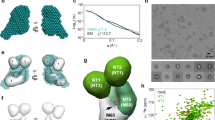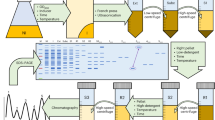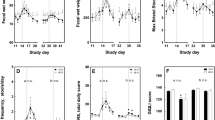Abstract
We have developed a screen for detecting E. coli colonies that produce soluble recombinant target proteins at the colony level: the colony filtration (CoFi) blot. Colonies are transferred, induced and lysed on a filter membrane that can separate soluble proteins from inclusion bodies. Upon lysis, the soluble proteins diffuse through the filter membrane and are captured on a nitrocellulose membrane. The nitrocellulose membrane is incubated with antibodies or probes specific for the target protein and are then developed. In the resulting image, colonies expressing soluble protein can easily be identified. This protocol can be used to screen thousands of constructs in a matter of days, making it very suitable for expression libraries. The protocol is robust and flexible with regard to lysis conditions, induction temperatures and strains. The method requires only standard laboratory equipment and is based on immunochemicals used for western blotting. The following protocol describes the screening of a DNA library with detection done using chemiluminescence. Depending on induction temperature, the whole procedure can be performed in <2 d.
This is a preview of subscription content, access via your institution
Access options
Subscribe to this journal
Receive 12 print issues and online access
$259.00 per year
only $21.58 per issue
Buy this article
- Purchase on SpringerLink
- Instant access to full article PDF
Prices may be subject to local taxes which are calculated during checkout




Similar content being viewed by others
References
Itakura, K. et al. Expression in Escherichia coli of a chemically synthesized gene for the hormone somatostatin. Science 198, 1056–1063 (1977).
Goeddel, D.V. et al. Expression in Escherichia coli of chemically synthesized genes for human insulin. Proc. Natl. Acad. Sci. USA 76, 106–110 (1979).
Goeddel, D.V. et al. Direct expression in Escherichia coli of a DNA sequence coding for human growth hormone. Nature 281, 544–548 (1979).
Taylor, G., Hoare, M., Gray, D.R. & Marston, F.A.O. Size and density of protein inclusion bodies. Bio/Technology 4, 553–557 (1986).
Baneyx, F. & Mujacic, M. Recombinant protein folding and misfolding in Escherichia coli. Nat. Biotechnol. 22, 1399–1408 (2004).
Braun, P. & LaBaer, J. High throughput protein production for functional proteomics. Trends Biotechnol. 21, 383–388 (2003).
Hammarstrom, M., Hellgren, N., Van den Berg, S., Berglund, H. & Hard, T. Rapid screening for improved solubility of small human proteins produced as fusion proteins in Escherichia coli. Protein Sci. 11, 313–321 (2002).
Knaust, R.K.C. & Nordlund, P. Screening for soluble expression of recombinant proteins in a 96-well format. Anal. Biochem. 297, 79–85 (2001).
Nguyen, H., Martinez, B., Oganesyan, N. & Kim, R. An automated small-scale protein expression and purification screening provides beneficial information for protein production. J. Struct. Funct. Genomics 5, 23–27 (2004).
Jenkins, T.M. et al. Catalytic domain of human immunodeficiency virus type 1 integrase—identification of a soluble mutant by systematic replacement of hydrophobic residues. Proc. Natl. Acad. Sci. USA 92, 6057–6061 (1995).
Knappik, A. & Pluckthun, A. Engineered turns of a recombinant antibody improve its in vivo folding. Protein Eng. 8, 81–89 (1995).
Dale, G.E., Broger, C., Langen, H., Darcy, A. & Stuber, D. Improving protein solubility through rationally designed amino-acid replacements—solubilization of the trimethoprim-resistant type S1 dihydrofolate reductase. Protein Eng. 7, 933–939 (1994).
Yang, J.K., Park, M.S., Waldo, G.S. & Suh, S.W. Directed evolution approach to a structural genomics project: Rv2002 from Mycobacterium tuberculosis. Proc. Natl. Acad. Sci. USA 100, 455–460 (2003).
Pedelacq, J.D. et al. Engineering soluble proteins for structural genomics. Nat. Biotechnol. 20, 927–932 (2002).
Cornvik, T. et al. Colony filtration blot: a new screening method for soluble protein expression in Escherichia coli. Nat. Methods 2, 507–509 (2005).
Waldo, G.S., Standish, B.M., Berendzen, J. & Terwilliger, T.C. Rapid protein-folding assay using green fluorescent protein. Nat. Biotechnol. 17, 691–695 (1999).
Maxwell, K.L., Mittermaier, A.K., Forman-Kay, J.D. & Davidson, A.R. A simple in vivo assay for increased protein solubility. Protein Sci. 8, 1908–1911 (1999).
Cabantous, S., Terwilliger, T.C. & Waldo, G.S. Protein tagging and detection with engineered self-assembling fragments of green fluorescent protein. Nat. Biotechnol. 23, 102–107 (2005).
Cornvik, T. et al. An efficient and generic strategy for producing soluble human proteins and domains in E. coli by screening construct libraries. Proteins (in the press).
Acknowledgements
The authors would like to acknowledge the Swedish Research Council, the Wallenberg Consortium North, the Göran Gustafsson Foundation for Research in Natural Science and Medicine and the European Community-supported program Structural Proteomics in Europe (SPINE) for financial support.
Author information
Authors and Affiliations
Corresponding author
Ethics declarations
Competing interests
P.N. and T.C. are the founders of the company Evitra AB, which may make use of the method described in this article.
Rights and permissions
About this article
Cite this article
Dahlroth, SL., Nordlund, P. & Cornvik, T. Colony filtration blotting for screening soluble expression in Escherichia coli. Nat Protoc 1, 253–258 (2006). https://doi.org/10.1038/nprot.2006.39
Published:
Issue date:
DOI: https://doi.org/10.1038/nprot.2006.39
This article is cited by
-
Structural characterization and heterologous expression of a new cyt gene cloned from Bacillus thuringiensis
Journal of Molecular Modeling (2019)
-
The Center for Optimized Structural Studies (COSS) platform for automation in cloning, expression, and purification of single proteins and protein–protein complexes
Amino Acids (2014)
-
Engineering protein thermostability using a generic activity-independent biophysical screen inside the cell
Nature Communications (2013)



